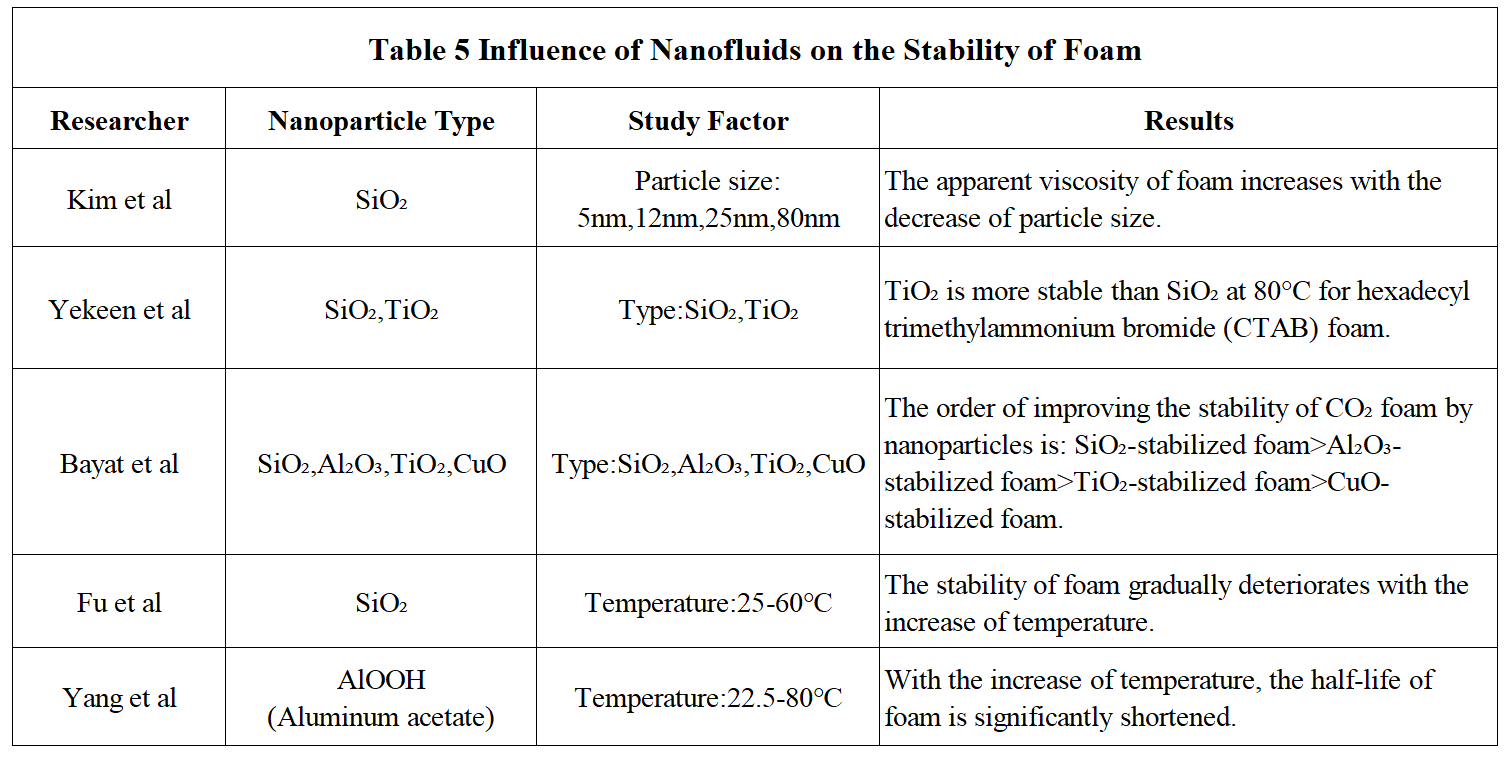Research and Application Progress on Nanofluid Enhanced Oil Recovery (Part 2)
3. Mechanism of Nanofluid Enhanced Oil Recovery
The reason why nanofluids have become a hot topic in current research on improving crude oil recovery is, on the one hand, because there are many mechanisms by which nanofluids can improve crude oil recovery, and compared with traditional chemical flooding, they have their unique performance; On the other hand, its low usage concentration and high economic benefits are in line with the current sluggish petroleum industry market. This article mainly introduces six mechanisms of improving oil recovery with nanofluids.
3.1 Reduce the Interfacial Tension between Oil and Water Phases
Figure 3 is a schematic diagram of the state of oil droplets in the pore throat under high oil-water interfacial tension and low oil-water interfacial tension.
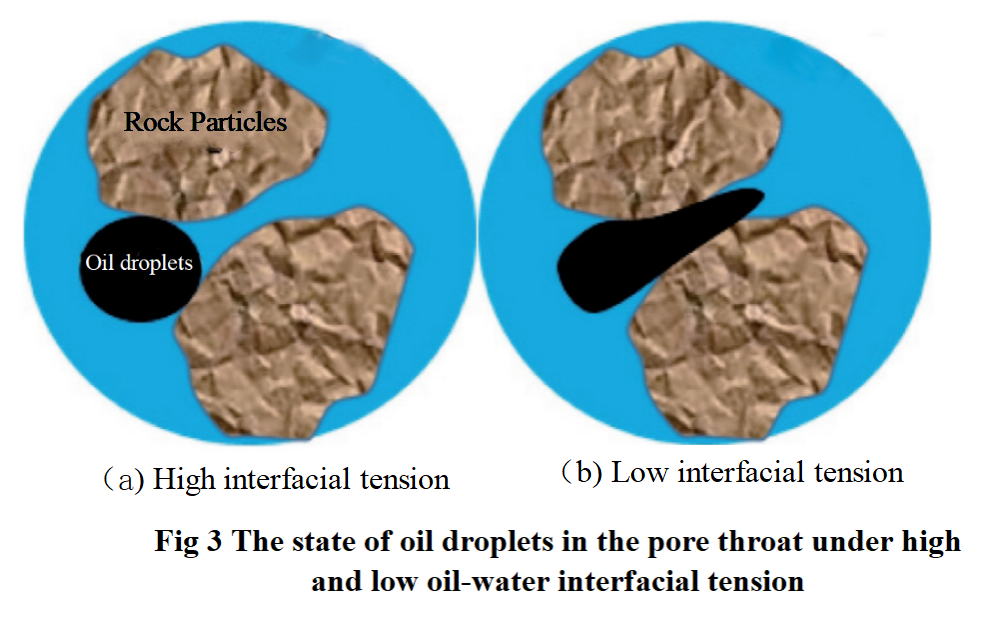
From Figure 3, it can be seen that when the interfacial tension between oil and water is high, oil droplets cannot pass through the pore throat and are trapped; When the interfacial tension between oil and water is low, oil droplets deform and pass through the pore throat. Therefore, the interfacial tension between oil and water phases is crucial for improving crude oil recovery. Sharma et al. and Deng et al. believe that the main mechanism by which nanoparticles reduce interfacial tension between oil and water phases is that nanoparticles can adsorb at the oil-water interface to form a nano layer. The hydrophilic part of the nanoparticles exists in the water phase, while the hydrophobic part exists in the oil phase. The nano layer replaces the pure oil-water interface, causing a change in the properties of the oil-water interface, thereby reducing the interfacial tension between the oil-water phases. Gao Jun et al. found that the interfacial tension between heavy oil and SiO2, Al2O3, and TiO2 nanofluids gradually decreases with the increase of nanoparticle concentration. However, Man-shad et al. showed that a single nanomaterial cannot significantly reduce the oil-water interfacial tension. It can be combined with surfactants or modified on the surface of nanoparticles to significantly reduce the oil-water interfacial tension and improve crude oil recovery. Li et al. condensed adipic acid with - OH groups on the surface of SiO2 to form active SiO2 nanoparticles. Compared with ordinary SiO2 nanoparticles, active SiO2 nanoparticles have a stronger ability to reduce oil-water interfacial tension. Luo et al. prepared amphiphilic GO nanosheets by modifying alkyl amines on the surface of GO. The study found that these amphiphilic nanosheets can spontaneously approach the oil-water interface and form an interfacial adsorption film with high viscoelasticity and low interfacial tension.
There are many factors that affect the reduction of interfacial tension between oil and water in nanofluids, mainly including nanoparticle concentration, particle size, surfactant concentration, temperature, and mineralization degree. Table 3 summarizes the research conducted by some scholars on the influence of different factors on interfacial tension.
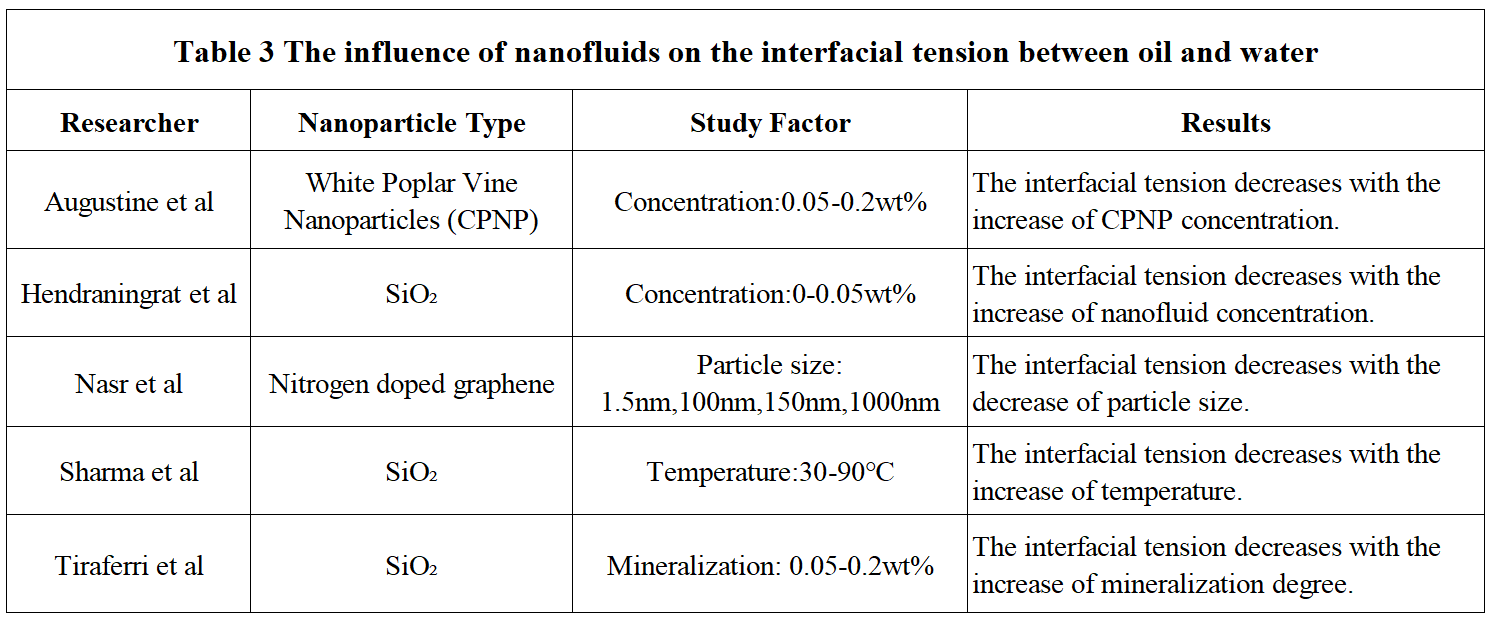
3.2 Improving the Wettability of Rock Walls
The wettability of reservoir rock walls is the main factor controlling fluid flow and distribution in reservoirs. Therefore, research on the wettability of reservoir rock walls is of great significance for improving oil recovery. The mechanism by which nanofluids alter the wettability of reservoir rock walls is the spreading and adsorption of nanoparticles on the rock walls. Radnia et al. attributed the reversal of wettability on rock walls to the combined effect of structural separation pressure and nanoparticle adsorption, as shown in Figure 4.
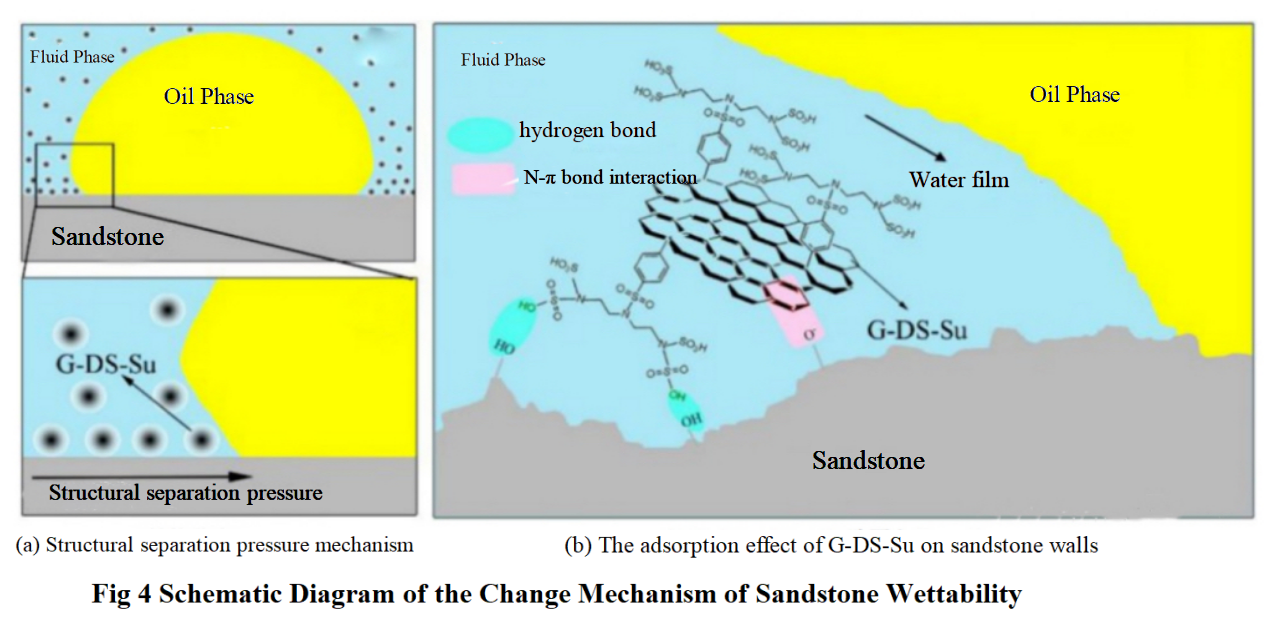
The adsorption process can also be attributed to the hydrogen bonding between the oxygen-containing groups of sulfonated graphene (G-DS-Su) and the silanol groups on the surface of sandstone, as well as the interaction between the -O- groups on the surface of sandstone and the π electrons of G-DS-Su. Bayat et al. found that the contact angles of Al2O3, TiO2, and SiO2 gradually decrease with increasing temperature. Although SiO2 has higher adsorption capacity on the surface of limestone compared to Al2O3 and TiO2 nanofluids (strong adsorption capacity means smaller contact angle), the effect of improving oil recovery is inferior to that of Al2O3 and TiO2 nanofluids. It is judged that the oil recovery effect of nanofluids in strongly hydrophilic reservoirs is not as good as that in neutral wetting reservoirs. Qu et al. found that amphiphilic MoS2 nanosheets modified with rhamnose ester molecules can reverse the surface of oil-wet quartz sheets to neutral wetting, and then the active sheet-like nanofluid can displace crude oil through piston displacement. The neutral wetting of the rock wall suppresses the increase in water film thickness caused by strong water wetting, and weakens the adverse effects of reduced flow channel size on improving oil recovery. Table 4 summarizes the factors and patterns that affect the wetting reversal effect of nanofluids, mainly including nanoparticle type, nanoparticle size, nanoparticle concentration, temperature, mineralization degree, and additives.
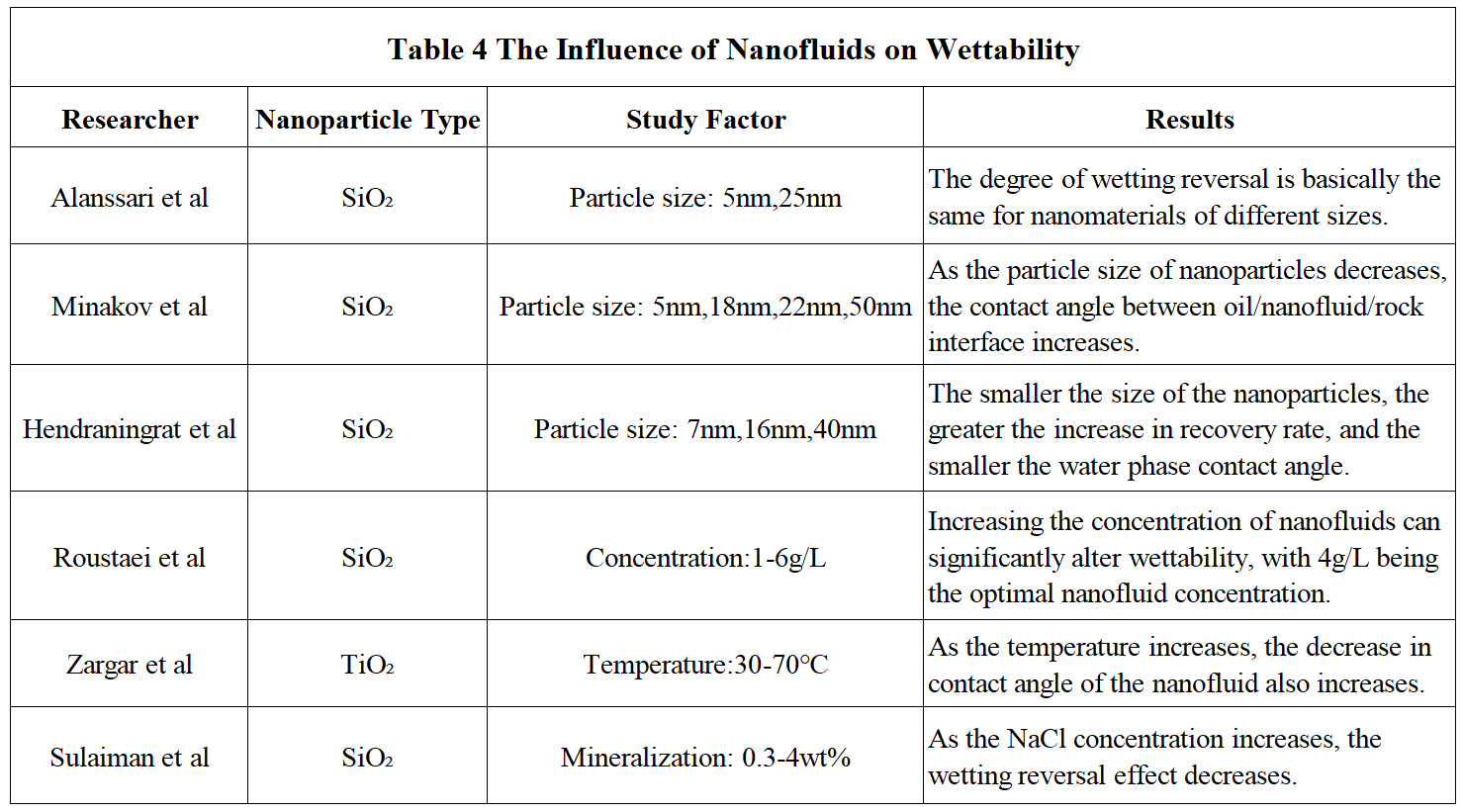
3.3 Reduce Crude Oil Viscosity
The introduction of nanoparticles allows the viscosity reducer to have a larger contact area with heavy oil. Through its own nano effect and the presence of strong polar functional groups on the surface, it can cause damage to the stacked structure of gum and asphaltene. In addition, the presence of nanostructured surfaces leads to boundary slip phenomena in resins and asphaltenes, which can achieve better viscosity reduction and flow effects. Shokrlu et al. found that nanoparticles have a significant impact on the heat transfer of heavy oil. When metal nanoparticles are present, the catalytic hydrolysis reaction of C-S bonds in gum and asphaltene components can significantly reduce the viscosity of heavy oil even at room temperature by reducing molecular weight. Iskandar et al. found that nanoparticles can serve as inhibitors by adsorbing onto the surface of resin and asphaltene, preventing aggregation, precipitation, and deposition behavior of resin and asphaltene, thereby achieving the goal of reducing crude oil viscosity. Elshawaf found that graphene oxide can significantly reduce the viscosity of heavy oil between 40~70 ℃, with a reduction range of 25%~60% of the original viscosity value of heavy oil, as shown in Figure 5.
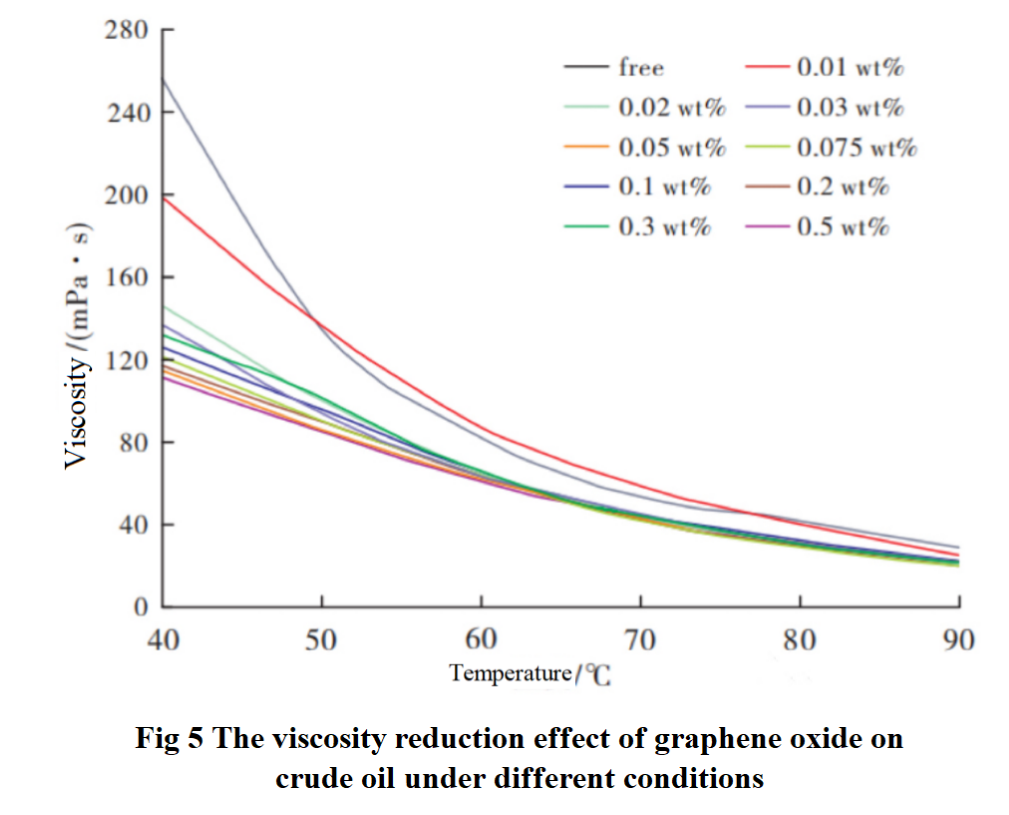
The main mechanism of graphene oxide viscosity reduction includes: the thermal conductivity of graphene oxide can reach up to 1300 W/(m · K), which is beneficial for heavy oil thermal recovery; Nanoscale graphene oxide is a catalyst for hydrolysis reactions, which helps to break bonds and interactions such as C-H, C=O, and C-S.
3.4 Improve the Stability of Foam
The main mechanism of stabilizing foam with nanoparticles is to improve the mechanical strength of the foam liquid film, form a network structure by adsorption on the gas-liquid surface facial mask, inhibit liquid discharge of the liquid film, reduce bubble coalescence, and improve the stability of foam. Once the nanoparticles are adsorbed on the gas liquid surface facial mask, if they want to leave the surface, they need a certain amount of energy, that is, separation energy. Compared with the surfactants and polymers that stabilize the foam, the nanoparticles need a higher separation energy because of their small size and high specific surface energy. Zhu et al. found that the amphoteric surfactant propyl erucic betaine (EAPB) can form a micellar particle network with hydrophilic nanoparticles in a series of concentrations to stabilize foam. Risal et al. modified the surface of SiO2 with γ-aminopropyltriethoxysilane (APTES) and obtained partially hydrophobic nanoparticles with APTES coverage of 40% and 60%. The research results show that partially hydrophobic nanoparticles with APTES coverage of 60% have good potential in stabilizing foam. The research results of Tang et al. show that smaller nanoparticles can stabilize foam more than larger ones, that is, the stability of foam generally increases with the decrease of the size of nanoparticles. Yekeen et al. found that for the sodium dodecyl sulfate (SDS) foam system added with Al2O3, when the salinity concentration increased from 0 to 1 wt%, the half-life of Al2O3-SDS foam gradually shortened; For the SiO2-SDS foam system, when the salinity concentration increases from 0 to 0.5 wt%, the half-life of the SiO2-SDS foam gradually shortens, while when the salinity concentration is greater than 0.5 wt%, the half-life of the SiO2-SDS foam lengthens. The size distribution comparison of different foam systems is shown in Figure 6.
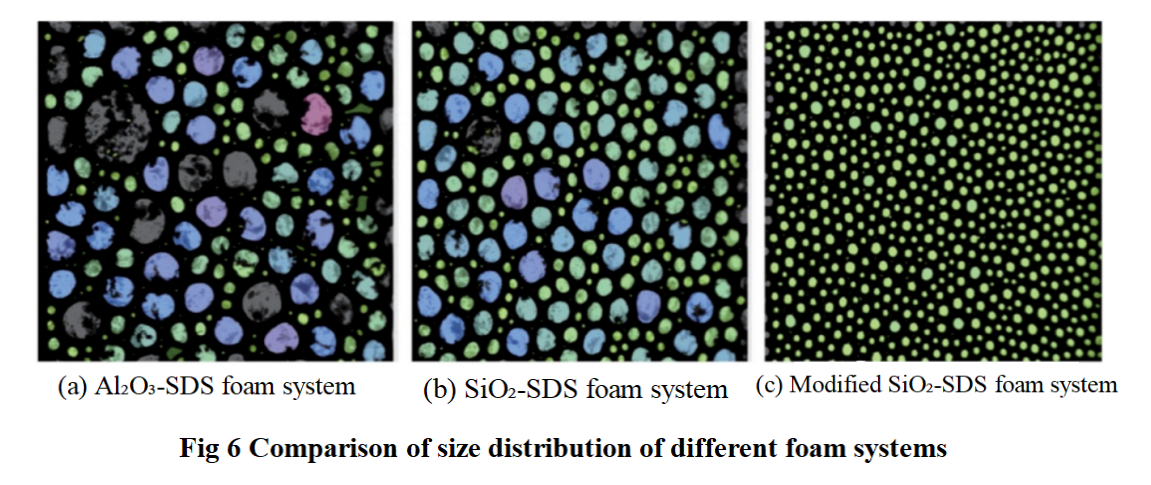
The factors affecting the stability of foam with nanoparticles include the size and type of nanoparticles, reservoir temperature, salt concentration, etc. Table 5 summarizes the rules and understanding of some scholars on the stability of foam with nanoparticles.
